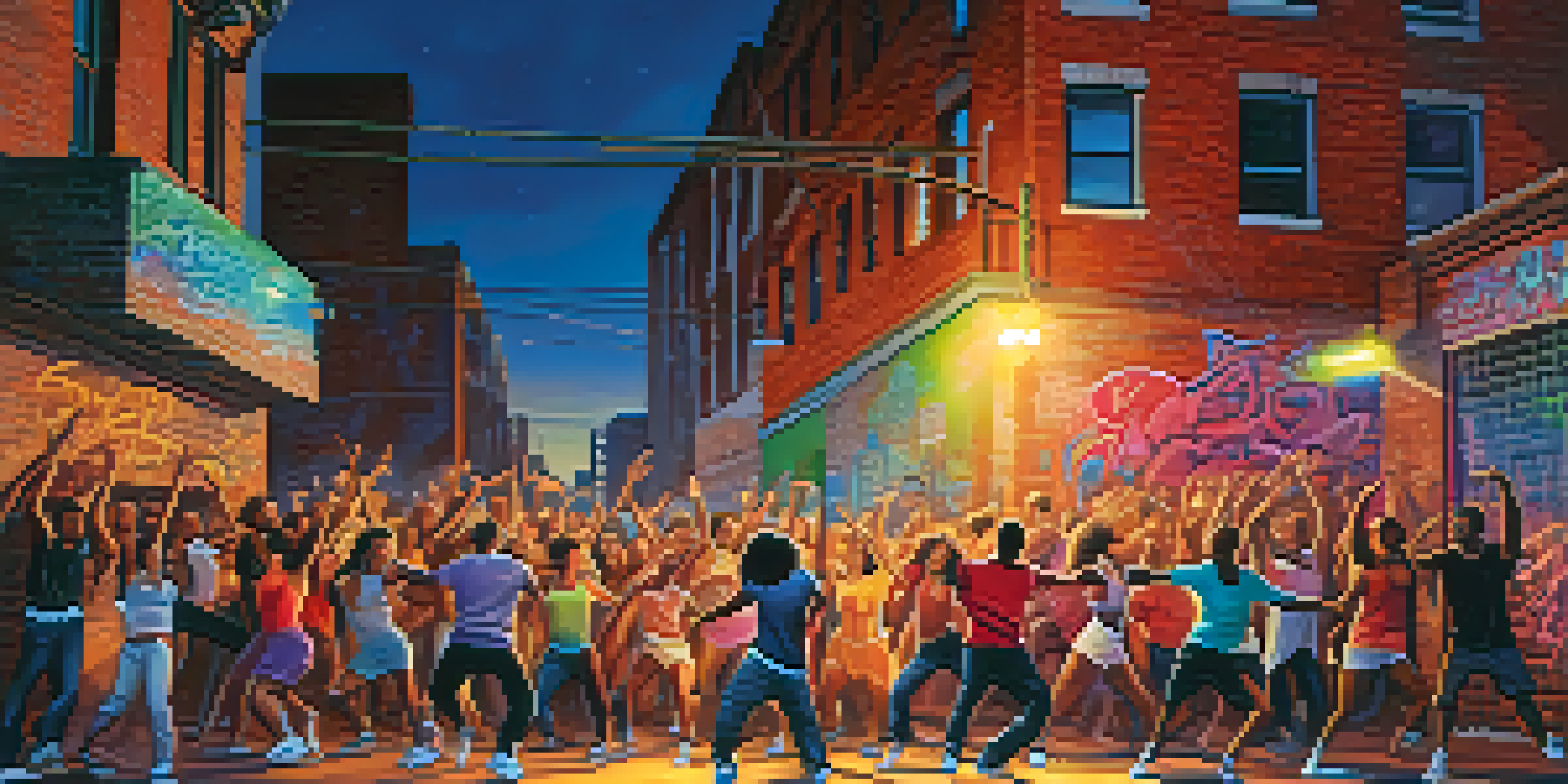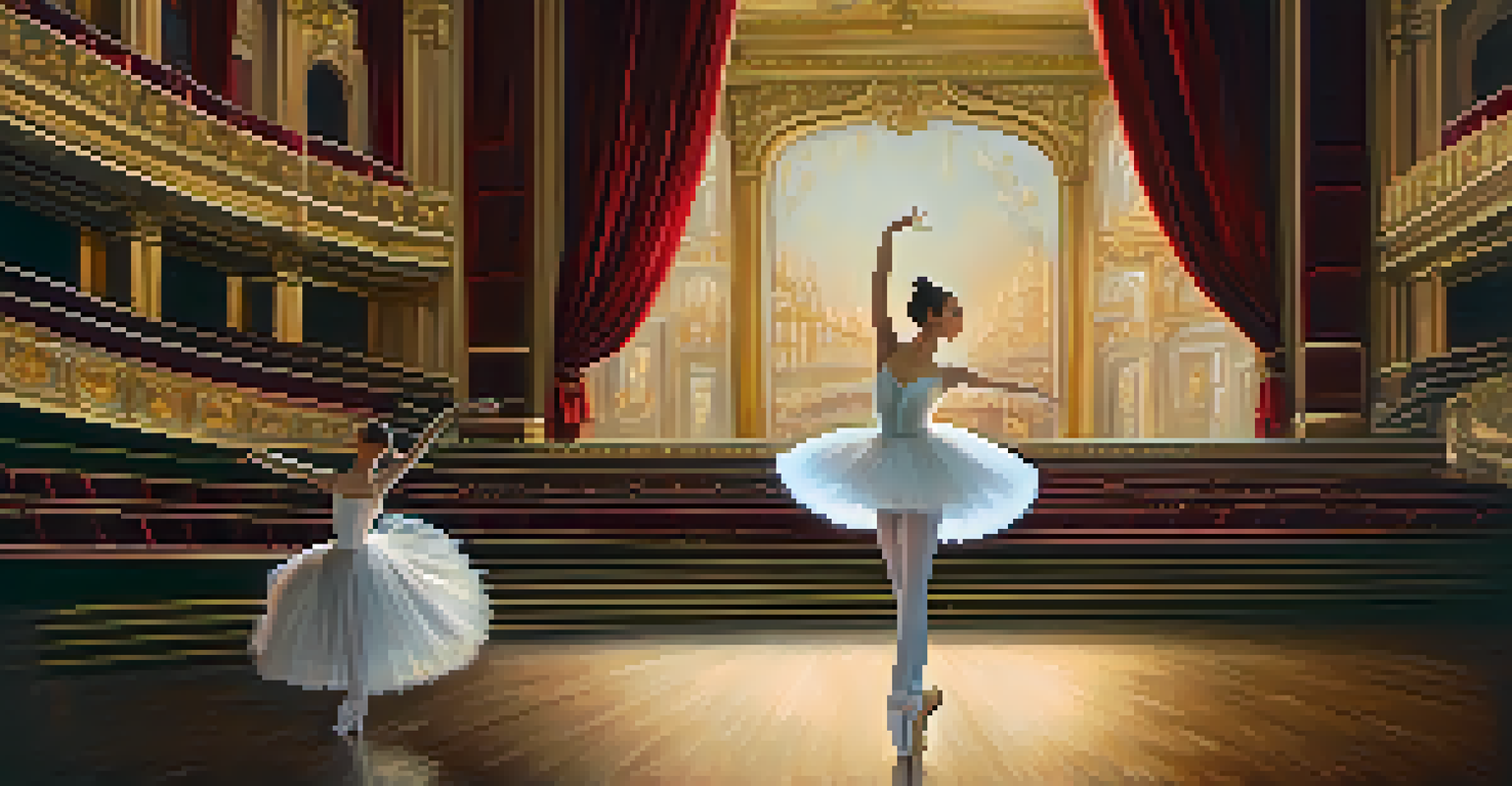Analyzing Dance Sequences in Film: Techniques and Styles

The Role of Dance in Storytelling
Dance in film serves as a powerful narrative tool, often conveying emotions and themes that dialogue alone cannot express. For instance, in movies like 'La La Land,' dance sequences beautifully illustrate the characters' aspirations and struggles, adding depth to their journeys. These choreographed moments can transform a simple story into a visually captivating experience, engaging the audience on multiple levels.
Dance is the hidden language of the soul.
Furthermore, dance can also highlight cultural contexts, reflecting societal values and traditions. In films like 'West Side Story,' the choreography mirrors the characters' backgrounds and conflicts, bridging the gap between music and narrative. This connection between movement and story not only enhances the viewing experience but also fosters a deeper understanding of the characters’ motivations.
Ultimately, dance sequences are not just entertainment; they are integral parts of the storytelling process. By analyzing these moments, we gain insights into how filmmakers use movement to evoke emotions and drive the plot, demonstrating that dance is a language all its own.
Choreography: Crafting Visual Narratives
Choreography plays a pivotal role in how dance is perceived in film. It involves not just the movements themselves but also the way they are arranged to create a cohesive story. Renowned choreographer Bob Fosse, known for his work in 'Chicago,' masterfully uses body angles and syncopated rhythms to convey the underlying tension of the narrative, illustrating how dance can enhance dramatic moments.

Moreover, the collaboration between choreographers and directors is essential to ensure that the dance fits seamlessly within the film's overall aesthetic. This partnership often results in innovative sequences that reflect the film's themes, as seen in films like 'Black Swan,' where the choreography symbolizes the protagonist's internal struggle. Such intentionality in choreography elevates dance from mere performance to an essential narrative device.
Dance as a Narrative Tool
Dance in film enhances storytelling by conveying emotions and themes that dialogue alone may not capture.
As we delve into specific choreographic styles, it becomes clear that each brings its own flavor to storytelling. From ballet to hip-hop, the choice of style directly influences how the audience interprets the characters’ emotions and actions, showcasing the versatility of dance in film.
Cinematic Techniques Enhancing Dance
Cinematic techniques, such as camera angles and editing, significantly enhance dance sequences, making them more dynamic and engaging. For example, the use of close-ups can capture the intricate details of a dancer's expression, while wide shots can showcase the choreography's scale. A great instance of this can be seen in the classic 'Singin' in the Rain,' where the camera dances alongside Gene Kelly, immersing the audience in the performance.
Choreography is the art of making things visible.
Moreover, the pacing of cuts in dance scenes can mirror the rhythm of the music, amplifying the emotional impact. Quick cuts during high-energy dance numbers can create an exhilarating atmosphere, while longer takes in more expressive sequences allow viewers to savor the artistry. This interplay between choreography and filming techniques can transform a simple dance into a breathtaking visual spectacle.
By analyzing how these techniques interact with dance, we can appreciate the artistry involved in creating memorable sequences. Each element, from framing to movement, combines to create a symphony of sight and sound, further engaging the audience and deepening their connection to the film.
Cultural Influences on Dance Styles
Dance styles in film are often deeply influenced by cultural contexts, reflecting the rich tapestry of traditions and practices from around the world. For instance, Bollywood films showcase vibrant dance sequences that are integral to the storytelling, combining classical Indian dance with contemporary influences. These performances not only entertain but also educate viewers about cultural nuances, creating a connection that transcends borders.
Similarly, films like 'Step Up' highlight urban dance styles, showcasing the evolution of hip-hop and street dance. These sequences often represent the voices of marginalized communities, bringing their stories to the forefront. By analyzing these cultural influences, we can better appreciate the diversity and significance of dance in film as a form of expression.
Choreography Shapes Film Aesthetics
The collaboration between choreographers and directors is crucial for creating dance sequences that seamlessly fit the film's narrative.
Ultimately, acknowledging these cultural underpinnings enriches our understanding of dance in cinema. It allows us to see how filmmakers use dance as a medium to celebrate heritage, challenge stereotypes, and foster empathy among audiences from different backgrounds.
The Evolution of Dance in Cinema
The evolution of dance in cinema reflects broader societal changes and technological advancements. From the early days of silent films, where simple gestures conveyed emotions, to the elaborate musical numbers of the Golden Age, dance has continually adapted to the times. For example, the introduction of sound revolutionized musical films, leading to iconic performances like those in 'The Sound of Music,' where dance and song became inseparable.
As technology progressed, filmmakers began to experiment with visual effects and innovative camera work, pushing the boundaries of traditional dance sequences. Films like 'In the Heights' utilize modern filming techniques to create vibrant and immersive dance experiences that resonate with contemporary audiences. This ongoing evolution emphasizes the adaptability of dance within the cinematic landscape.
Moreover, the rise of digital media has allowed for new forms of dance expression, such as dance films on streaming platforms. This shift not only democratizes access to dance but also inspires a new generation of filmmakers and dancers to explore the art form in unique ways, ensuring that dance continues to thrive in cinema.
Iconic Dance Scenes That Define Genres
Certain dance scenes have become iconic, defining genres and influencing countless films that followed. Think of the unforgettable dance-off in 'Pulp Fiction' or the passionate tango in 'Evita'—each sequence not only captivates viewers but also sets a standard for how dance can enhance storytelling. These moments become cultural touchstones, often referenced or parodied in other media, showcasing their lasting impact.
Moreover, these iconic scenes often serve to crystallize the film's themes and character arcs. For instance, the dance sequences in 'Dirty Dancing' symbolize the characters' journey toward self-discovery and liberation. By analyzing these moments, we can see how they encapsulate the essence of the films, making them memorable and influential.
Cultural Influences on Dance Styles
Dance styles in film reflect cultural contexts, showcasing diverse traditions and fostering connections among audiences.
Recognizing these seminal dance moments allows us to appreciate the artistry involved in their creation. From choreography to performance and cinematography, every element contributes to the lasting impression these scenes leave on audiences, reinforcing dance's pivotal role in film.
Future Trends in Dance on Screen
As we look to the future, dance in film is poised to evolve further with the integration of technology and new storytelling methods. Virtual reality and augmented reality are beginning to make their mark, offering immersive experiences where viewers can engage with dance like never before. This innovation presents exciting opportunities for filmmakers to explore how dance can be experienced beyond traditional screens.
Additionally, the rise of social media platforms has given dancers a larger stage, allowing them to showcase their talents and collaborate with filmmakers worldwide. This trend not only democratizes dance but also encourages a fusion of styles, leading to fresh and diverse representations of movement in film. The accessibility of these platforms fosters creativity and inspires new narratives that reflect contemporary culture.

Ultimately, the future of dance in cinema will likely be shaped by these technological advancements and evolving cultural dynamics. As filmmakers and dancers continue to push boundaries, we can expect to see even more innovative and inspiring dance sequences that captivate audiences for years to come.